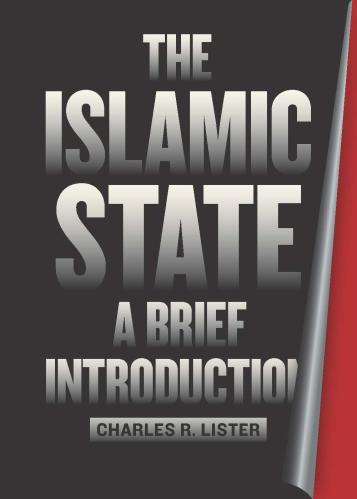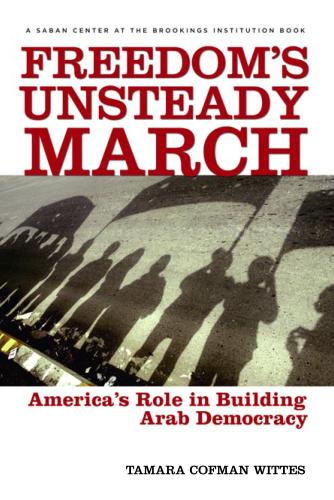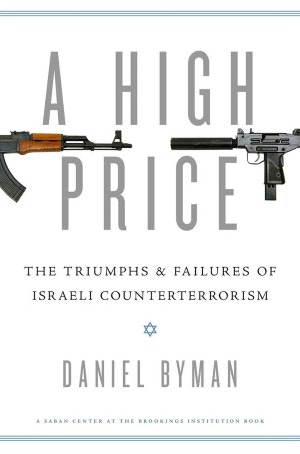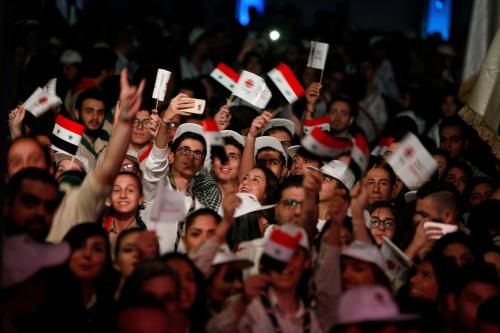Yesterday, I released a new report on the future of governance in Arab states.
This may seem like an inapt, or even irrelevant, moment to argue for the imperative of improving governance in the Middle East. After all, the region is facing unprecedented turmoil: civil wars that have displaced millions of people and killed more than half a million; vicious extremist movements that massacre civilians, conduct terrorist attacks, and oppress those under its rule; and, of course, the United States and its allies are now invested in a new war in Iraq and Syria fighting ISIS.
I just came back from the Halifax International Security Forum and the only discussion of the Middle East there was framed around terrorism, ISIS, civil war, and refugees. Those are the urgent problems that are seen by many governments around the world as a threat to international security, and that are driving global attention to the region.
But ISIS and civil wars are symptoms of a broader deterioration in the region—they are not the disease. Beginning in 2011, the Middle East endured the breakdown both of states, and of a state system that had lasted for about the prior half-century. That old Middle Eastern state system had advantaged American interests and those of U.S. regional partners, and the United States defended it resolutely. That order is now gone, and the region is in turmoil. The breakdown of that old order is what led to the civil wars in Yemen, Libya, and Syria, and what enabled the rise of ISIS.
We need to understand why and how the Middle East broke down in order to effectively deal with the urgent security challenges that this breakdown generated, and how to return stability to the region. Otherwise, as my colleague General John Allen has noted, the war on terrorism will never be won—instead, we will be fighting ISIS 2.0 and ISIS 3.0 on and on into the future.
In the new report, I argue that the regional breakdown transpired primarily because of failures of governance. The paper analyzes the “how” and “why” of those failures in order to illuminate the future of stable governance in this disordered region, and to suggest policies that the United States and others might pursue to achieve what this paper calls “real security.”
Three Facts About the Middle East’s Disorder:
1) The regional order did not break down primarily because of external invasions, or top-down decisions, but because of forces within states and societies, pressures that built up over many years. I told part of the story of this breakdown in my 2008 book, “Freedom’s Unsteady March“: the story of how the bureaucratic authoritarian model in the Arab world began to weaken—how the clientelism, the ideology, and the coercion on which these states relied to survive became less and less effective in a globalized world.
The Arab states of the last half-century rested on a particular social contract: a patronage system in which citizens gave their consent to the regime, and in exchange the regime provided all kinds of economic and social goods to people.
The Arab states of the last half-century rested on a particular social contract: a patronage system in which citizens gave their consent to the regime, and in exchange the regime provided all kinds of economic and social goods to people: not just security but healthcare, education, social services, and jobs. In Egypt, for many years, the government promised all university graduates a civil service job, which was essentially a lifetime sinecure. An Egyptian friend of mine, who spent many decades working for a state-owned newspaper, described to me that on Fridays he used to come to work with a plastic bag because the newspaper used to give each of the workers in his office a chicken to take home for dinner. That was the corporatist state, the old social contract in action.
Over time, these inefficient patronage systems became especially challenged by the emergence of three major forces: a massive demographic bulge of young people on the cusp of adulthood; the penetration of a globalized economy; and a radically new information environment generated first by satellite television and then by the internet and mobile technology.
As a result of these three forces, states became not just inefficient, but increasingly ineffective, at providing the goods that citizens expected. And so by the early 2000s, those Egyptian university graduates had to wait to get their promised government job for an average of eight years. Young Egyptians spent eight years driving taxis or pushing food carts while waiting for that job to come at last. And when you are young, in a traditional society, and you have no permanent job, you can’t afford to get your own apartment, you can’t get married—in other words, you can’t become a fully adult person—you remain stuck.
2) Previous efforts to reform the social contract often made things worse, not better. It’s crucial to realize that no one, in the run-up to the Arab uprisings of 2011, was unaware of these problems. In the 1990s and 2000s, many in government, the private sector, and civil society, both in the region and in the West, were talking about the need for “reform.” The Europeans had the Barcelona Process, the United States had the Freedom Agenda.
But when Arab governments attempted to adjust the social contract in their nations in order to accommodate the impact of globalization and the rise of youth, they did not develop a more inclusive social contract that could establish a solid and lasting ruling coalition. Instead, they negotiated adjustments with political and economic elites. They made reform commitments to the World Bank and the IMF. They sold off state assets to those with access and wealth. They reduced government hiring without freeing up the private sector for real growth. They brought new business cronies into ruling parties instead of opening up politics to wider participation. The resulting adjustments further empowered select groups while further excluding others, exacerbated inequality, increased state capture by elites, and thus generated more and more widely held grievances against these regimes.
Consequently, discontent and protest increased, and the forces of globalization and technology meant that governments were less able to use patronage and ideology to keep people in line. Left with few effective tools, Arab governments saw increased expressions of dissent and fell back on coercion to suppress them. And this breakdown in the social contract between ruler and ruled, this cycle of dissent and repression, is what produced the Arab uprisings of 2011.
3) Finally, to understand the challenges that the Middle East faces today, we have to understand the consequences of how certain states broke down. When the protests came, many governments responded poorly, in ways that exacerbated societal divisions, and further weakened and in some cases collapsed state institutions. Some governments responded particularly badly, in ways that generated violence, enabled the growth of terrorist movements, and has morphed in at least three countries into outright civil war.
It is no accident that Syria and Libya are the most disordered and violent parts of the region today. These are the places where leaders ruled in a more personalized, less bureaucratized manner. They undermined and in Gadhafi’s case eviscerated, existing social and civic institutions, so they could keep their populations divided and perpetuate themselves in power. Then, having failed to act in a manner that could have prevented mass popular uprisings, they sought to repress their people through the use of force.
As basic governance and community order failed, those with guns to impose their will gained power. As the state apparatus turned against its own citizens, those citizens turned elsewhere for protection—toward identity-based, sectarian militias and toward extremist groups, often with horrific agendas.
Instead of restoring order, these brutal, power-hungry and shortsighted men broke their crumbling states to bits and drove their societies to civil war. The terrible choices of these terrible leaders, more than anything else, created the openings al-Qaida, ISIS, and sectarian killers across the region now exploit for their own purposes, including to threaten American interests.
What’s Left Behind: Broken Social Trust
By the time the Egyptian, Tunisian, and Libyan governments regimes fell in 2011, the social contract had broken down, and social trust had been deeply eroded. Further, because of the legacy of autocratic rule, there was very little left beneath to help manage social relations or to enable peaceful politics. In Syria and Libya, government violence and sectarian violence have further destroyed what was left of social trust.
Therefore, in addition to the geopolitical competition between Iran and Saudi Arabia, in addition to the threats posed by extremist terrorism and weapons of mass destruction, this breakdown of social trust within societies is in a way the biggest challenge to rebuilding regional order, since it is a consequence both of the way they were governed and of the way they broke down.
No state is immune from the imperative to repair governance and rebuild the social contract.
Several states have now collapsed into civil war, but more remain vulnerable to instability. The drivers of change—the demographic bulge, the technological effects, the economic dysfunctions—exist all across the region, in every environment. No state is immune from the imperative to repair governance and rebuild the social contract.
The biggest issue to my mind is what is happening inside states and communities—how do we prevent further breakdowns that destabilize the region even more, that give ISIS or other extremists, or Iran, even more openings?
I reject the axiom that the key to building a new stable order in today’s Middle East is fundamentally about territory and state borders. I think we have to focus on this issue of social trust.
Social trust is about communities being able to live together and share power, and that’s a problem no matter where you draw the political boundary. There’s no line you can draw between Shiite and Sunni in Iraq that won’t be fought over and, as the case of South Sudan shows, drawing new lines does not in itself end war. This suggests that the challenge is not map-making, it’s politics.
Likewise, highlighting the problem of social trust helps us avoid too much focus on institution-building. After its military victories in Iraq and Afghanistan, the United States and its allies spent a lot of time designing and propping up new state institutions: parliaments, courts, political parties, central banks—with the idea that once this complex machine of government is constructed, and the gears begin to turn, it will automatically begin working.
But we learned in Iraq and Afghanistan that building institutions is not enough. It matters how political institutions are populated, by whom, and for what purpose. Are they inclusive of all those with a stake in the process? Do they have a process that people think is fair?
Ultimately, stabilizing the Middle East requires creating capacity in these communities for negotiation, for compromise, for conflict resolution, for politics—because everywhere in the world, through human history—if differences are not resolved peacefully, they will be resolved through violent means.
So how do we rebuild social trust? It is not something you can rebuild from the outside in, or from the top down. It is something you begin to rebuild from the very local level, neighbor to neighbor, community to community, and ultimately building up to the national level.
The Road Ahead
My new paper offers much more detail on these subjects, and also offers some specific priorities and approaches for a way forward. Herewith, a few highlights:
- The future of the region will largely be determined by the quality of governance, not its mere existence. Governance that will last, and that will position states to be effective and reliable partners in maintaining regional stability, will have four key characteristics: it will be more inclusive, more transparent, more effective, and more accountable. Such characteristics are best realized, in my view, in liberal democracy.The paper details the alternative models of governance competing in the region today: the fragile democracy represented by Tunisia, the renewed authoritarianism represented by Egypt, or brutal ISIS rule that offers order through savagery. But the latter two models are not sustainable except at the cost of continued, escalating violence.
- The deficit of social trust means that sustainable governance in the Middle East of the future will be much more decentralized than in the past—not just because of ethnic or sectarian divisions, but because of the broader need to build governance in a way that citizens can see, feel, and buy into.Whether in Morocco, where the new constitution gave local councils more budget and more authority; or Lebanon, where there was no president for nearly two years and people simply don’t expect their national government to do anything for them; or Iraq, where the government in Baghdad is struggling to set conditions for locally-effective government in areas liberated from ISIS, or Libya, where it’s clear that no one man will ever again control the entire country—local governance in where the rubber meets the road for Arab citizens, and local governance is what we need to focus on to replace cynicism, violence and mistrust with stable governance.
- There is a sharp need to focus on dialogue and conflict resolution. It seems a very prosaic point to make, but war is the continuation of politics by other means. If people can’t settle their differences peacefully they will seek to settle them with violence. A basic aspiration for the future of the Middle East is to shift the conflicts now underway from a violent channel to a nonviolent channel. That would be a big improvement. In places that are still in conflict, or emerging from conflict, we have to work on equipping people with skills to manage conflicts peacefully. We can do this now, even while conflict continues, working with refugees and internally displaced persons, and with local civil administration in areas that are not under attack.
- Don’t neglect the vulnerabilities within the states that are still standing. The last thing this region needs is further breakdown, and yet there are states in the region that survived the 2011 uprisings despite hosting the same pressures for change that existed in Egypt and Tunisia. Where politics is stage-managed or simply repressed, eventually those public grievances will find an outlet through mass mobilization or violence. Even in states that are still functioning, governments need to tackle the real issues of meeting citizens’ expectations. They need to address inclusion and transparency, and need to be more responsive and more accountable. There are potential trouble spots around the region, where leaders are aging and succession is unclear—Algeria and the Palestinian Authority are prime examples. Without fair processes that people believe in, those political transitions could cause a crisis as it did in Egypt.
The Role of the United States
Without overwhelming force, external actors cannot determine outcomes in the Middle East at a moment when regional actors feel such a sense of existential challenge. But outsiders, especially the United States, do have a significant role to play, by conditioning the environment within which regional actors will make choices about how to face the challenges ahead of them. As they weigh a commitment to the long-term project of a stable and sustainable region, the United States and other governments with a stake in the Middle East should have three urgent priorities:
- Preventing further breakdowns across the region (that means attending to the vulnerabilities of unreformed governments and pressing them to reform),
- Seeking a swift end to the region’s civil wars; and,
- Building resilience through dialogue and conflict resolution in communities beset by or emerging from conflict.
The transformations necessary for stable governance in the Middle East may take years to be firmly established, but there is no alternative functional and sustainable model left for governance in this region. The question for American policy therefore becomes, at a moment when the American public attends little and cares less for foreign policy, can we commit to the persistent approach necessary to help move the region back from the brink of chaos and toward a more sustainable future? I hope my new report will help catalyze that necessary discussion.
The Brookings Institution is committed to quality, independence, and impact.
We are supported by a diverse array of funders. In line with our values and policies, each Brookings publication represents the sole views of its author(s).









Commentary
Want to stabilize the Middle East? Start with governance
November 22, 2016